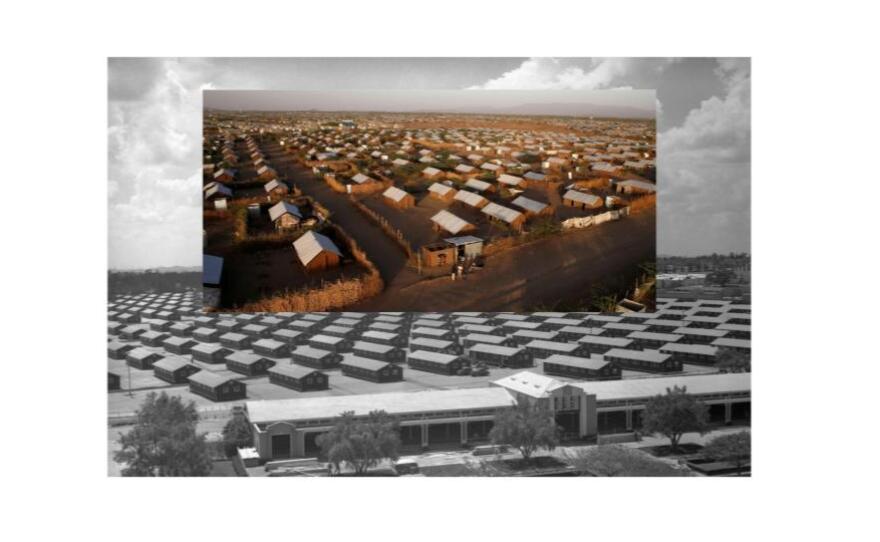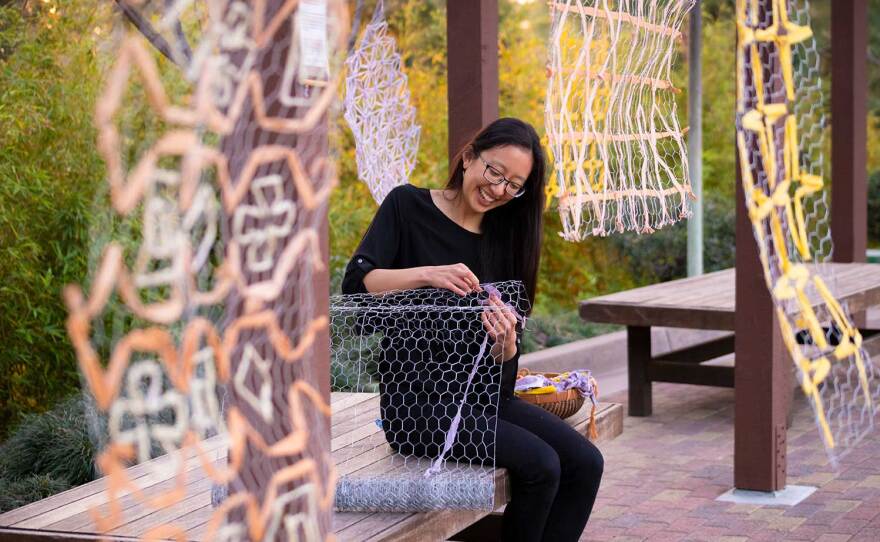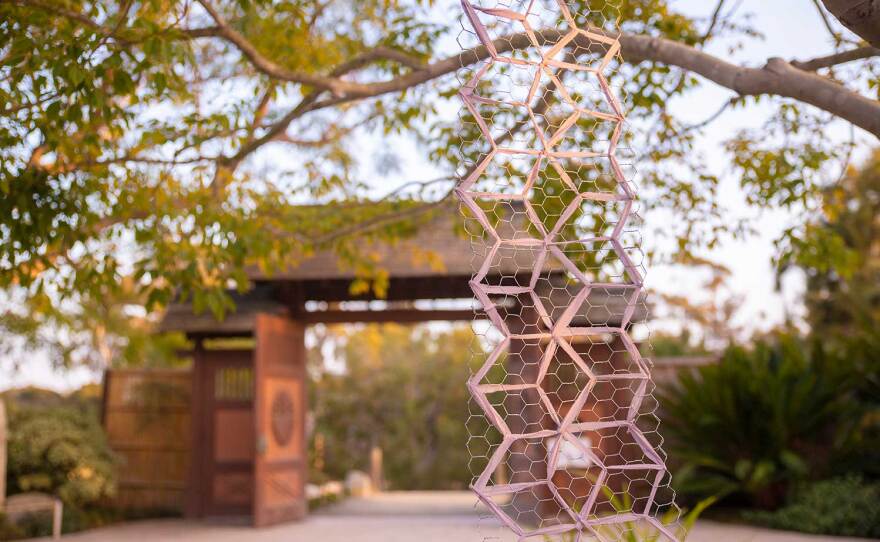The AjA Project is a City Heights-based creative organization that helps youth, activists and artists with what they refer to as "participatory photography" and other forms of storytelling and archiving.
In September, AjA kicked off the first cohort of the Civil Liberties Project with three fellows: Famo Musa, Kristi Lin and Natalia Quintero. Since then, the three artists have worked together to explore the relationship between their own family histories, concepts of memories and archives, and civil liberties violations — both in general and the specific case of the Japanese-American incarceration during WWII.
To close the fellowship, the artists each created separate, public exhibitions in art spaces across San Diego. All three open for a limited time this week.
"It was interesting that we are from three different backgrounds, a bunch of different places, but at the same time, we are heading to the same path," said artist Famo Musa, who is one of the cofounders of City Heights Youth For Change. "We all had this theme of cultural preservation, and we had this theme of fabric."
Famo Musa, 'Fragments of Memories'
Musa was born in Somalia and, as a child, spent time as a refugee in Kenya before coming to the United States. As the fellows studied photography from the Japanese-American internment camps, Musa was struck by the similarities to her time in the Kakuma Refugee Camp.
In fact, she collaged two images for part of the project: a picture of the refugee camp and a California internment camp with a haunting resemblance.
"They're both built by the United States for two different purposes, where one is a sanctuary and one is basically a prison," she said. "I thought it was interesting that two different worlds could collide like that."

Fama Musa: 'Fragments of Memories'
- On view from sidewalk, Feb. 10-16
- You Belong Here
- 3619 El Cajon Blvd, City Heights
Kristi Lin: 'Borrowed Scenery'
- On view outside, Feb. 11-28
- Japanese Friendship Garden
- 2215 Pan American Rd. E., Balboa Park
- On view from sidewalk (or indoors by appointment), Feb. 2-18
- The Front Arte Cultura
- 147 W. San Ysidro Blvd., San Ysidro
Virtual walkthrough of all three Civil Liberties Project fellows: Feb 13, 5-6:30 p.m.
Musa's work, and the resultant exhibition at You Belong Here, focuses on the smaller details or relocation: particularly in being able or allowed to carry a few possessions with you. She was inspired by seeing the individuals in the Japanese-American internment camps using skills they could bring along, like sewing, and comparing that to her own mother, who similarly brought her skill of sewing to create textiles to decorate the house.
But the exhibition centers around the auditory collection of her mother's stories.
Musa sat her mother down — while sewing — to recount everything she went through in her many relocations. She'll broadcast the audio recordings throughout the exhibit space.
She's also recreating her mother's room, with fabrics her mother made hanging throughout the space, and also projections of as much photography as she could uncover.
"I don’t have images of me when I was growing up, in Somalia, or in Kenya in the refugee camp. Photos weren’t the first thing they thought about picking up, same thing with the internment camps," Musa said.
When asked what her mother thinks of the final project, Musa laughed. "She's going to be shocked. I've talked about it in theory, but she hasn't seen the bigger picture yet." Musa will walk her mother through the exhibition after she installs it this week. "She doesn't know what's coming," she said, but added that her mother just wanted to make sure the audiences knew that textiles are her business.
Kristi Lin, 'Borrowed Scenery'
Across town at Balboa Park's Japanese Friendship Garden, Kristi Lin will install a series of fiber and metal works in the tradition of the "borrowed scenery" form found in both Japanese (shakkei) and Chinese (jièjǐng) garden design.
"[Borrowed scenery] is when a designer takes a view that's outside of the landscape, like a distant mountain or something. And they actually incorporate it seamlessly into the garden composition," said Lin. "I'm fourth generation Japanese-American and third generation Chinese-American, and so I'm taking that concept and using it as kind of a way to borrow these historic cultures into my life."

In her weaving, Lin used her old clothes, dyed using food scraps like onion skin, avocado or black beans.
"My food and my clothes become woven in these traditional Asian patterns onto these screens that create the composition through which we view the borrowed scenery of the Japanese Friendship Garden, and as the piece lives in the garden outside, it's going to change with the sun, move in the wind and cast shadows. It's going to really create this space that we can’t predict," said Lin.
Lin also wove that idea of predictability into her work. Looking at the Japanese-American incarceration and at the way stories and memories are archived, she thinks that the preservation of culture and the way future generations interpret their heritage is something also unpredictable.
An artist and a landscape designer, Lin was as inspired by the archived photographs of gardeners working in the camps as she was by an image of women making massive camouflage burlap netting that would be used by the United States armed forces in the war.
"That was kind of my first inspiration for the project, thinking about camouflaging and assimilation. What if we recreated those nets but did it in a way that's non-assimilation, really like not trying to hide?"

In working together with the other AjA fellows, Lin said they discussed the "language of fabric," a lot, and the ways their ancestors made objects, whether useful or decorative. "I think we all wanted to put ourselves in this practice of making something really slow," Lin said.
Natalia Quintero, 'Mending'
In San Ysidro, at The Front Arte and Cultura, artist Natalia Quintero's installation involves a series of dresses, garments and textiles, installed in windows or hanging in ghost-like forms.
Each piece evokes not just the people who made the garment, but also draws the eye to the missing shape of a body from the dress. Quintero explores the stories of minority women, and specifically the ways they are erased and excluded, guided and focused through the fellowship by the stories of women in Japanese-American internment camps.

Quintero's exhibition can be viewed from the sidewalk, day or night, but viewers can also take a closer look indoors by making an appointment at The Front.
For the AjA Project, this year's Civil Liberties fellowship is the pilot program, facilitated by teaching artists Dana Washington-Queen and Luisa Martínez. The project was structured partly like an academic program with a syllabus, discussion and discourse and partly in the form of public exhibitions to engage the community — all viewable from the outside for better COVID safety.
In addition to these public exhibitions, on Saturday, Feb. 13, the group will present a virtual walkthrough, together, of each exhibition, and discuss their findings and work throughout the fellowship.






